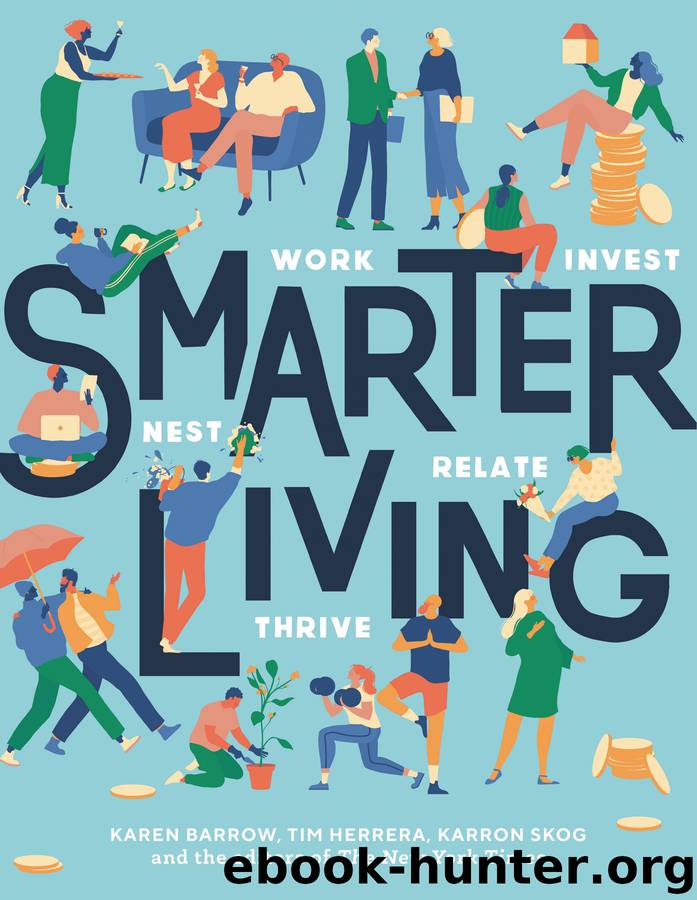Smarter Living by Karen Barrow & Tim Herrera & Karron Skog

Author:Karen Barrow & Tim Herrera & Karron Skog
Language: eng
Format: epub
Publisher: Running Press
Published: 2019-12-02T16:00:00+00:00
THE 50-30-20 BUDGET
This is a simple, effective way to allocate your post-tax income. It splits your spending into three categories:
Fixed expenses:
Rent, bills and loan repayment
Discretionary expenses:
Food, clothing and entertainment
Long-term savings:
401(k) or Roth IRA
WE JUST HAD TO ASK…
What is the worst money decision you’ve ever made?
After my husband and I got married, we hired a financial planner to manage our investments. We’d have quarterly meetings with her, but I wasn’t looking under the hood. I launched my podcast around that time, and my first guest was Tony Robbins, who talked to me a lot about fees. He was saying, You think you’re doing so well because you have this beautiful, diversified, asset-allocated portfolio, but do you know how much that costs in terms of the management fee? It may be a small percentage difference, but if you’ve invested thousands of dollars for the next 30 years, that can be tens of thousands in fees. I emailed our planner to send me the expense ratios for all our funds, and there were a handful of funds that qualified as too expensive, i.e., over 1.5 percent. Some she justified; others we got rid of. Eventually, we gave up having a planner entirely. She’d set things up, giving us big-picture guidance, and now it was time to do it ourselves.
—Farnoosh Torabi, creator and host of the “So Money” podcast, and author of When She Makes More
My first job was at a personal finance magazine, so on the advice of my very smart co-workers, I started contributing to a 401(k) right away. But until the end of 2018, I still hadn’t opened a Roth IRA, which is a favorite financial account of many financial writers. Though I knew I should open one, I didn’t at first because I figured the 401(k) was good enough. Then I wrote an article going in depth on Roths, and I realized it is a better vehicle for a lot of people, especially for younger people. With the traditional workplace 401(k), you’re getting a predetermined set of funds and things you can invest in, and sometimes the fees are higher. With a Roth, there are more options, and since you’re contributing money you’ve already been taxed on, you don’t pay taxes on the money or the earnings when you take them out, and you can take out your contributions anytime. There are a few rules and restrictions, of course, but it’s a lot more flexible than 401(k)s or traditional IRAs, and it’s probably a better deal for a lot of people. I write about the benefits all the time, and I even tell my friends to open one, but it took around three years to actually invest money in one and check it off my to-do list. It was just this weird mental block I had.
—Alicia Adamczyk, personal finance writer at the website Lifehacker
Download
This site does not store any files on its server. We only index and link to content provided by other sites. Please contact the content providers to delete copyright contents if any and email us, we'll remove relevant links or contents immediately.
The Body: A Guide for Occupants by Bill Bryson(4974)
Audition by Ryu Murakami(4850)
Adulting by Kelly Williams Brown(4487)
Housekeeping by Marilynne Robinson(4346)
Be in a Treehouse by Pete Nelson(3945)
Zero Waste Home by Bea Johnson(3777)
Seriously... I'm Kidding by Ellen DeGeneres(3577)
Better Homes and Gardens New Cookbook by Better Homes & Gardens(3525)
The Healing Self by Deepak Chopra(3474)
Barkskins by Annie Proulx(3312)
Hedgerow by John Wright(3275)
The Cellar by Natasha Preston(3260)
Spark Joy by Marie Kondo(3249)
The Genius of Japanese Carpentry by Azby Brown(3224)
The Life-Changing Magic Of Tidying Up- The Japanese Art Of Decluttering And Organizing (v5.0) by Marie Kondo(3211)
120 Days of Sodom by Marquis de Sade(3179)
Work Clean by Dan Charnas(3048)
The Book of Numbers by Peter Bentley(2912)
A Monk's Guide to a Clean House and Mind by Shoukei Matsumoto(2867)
